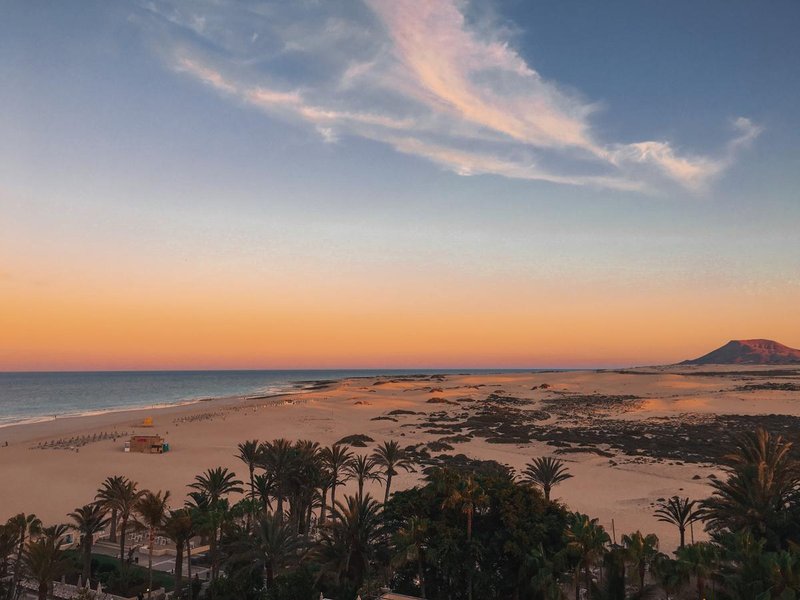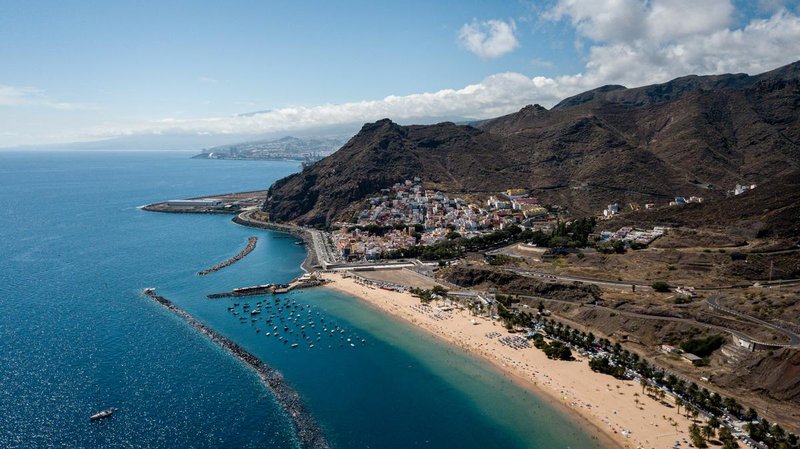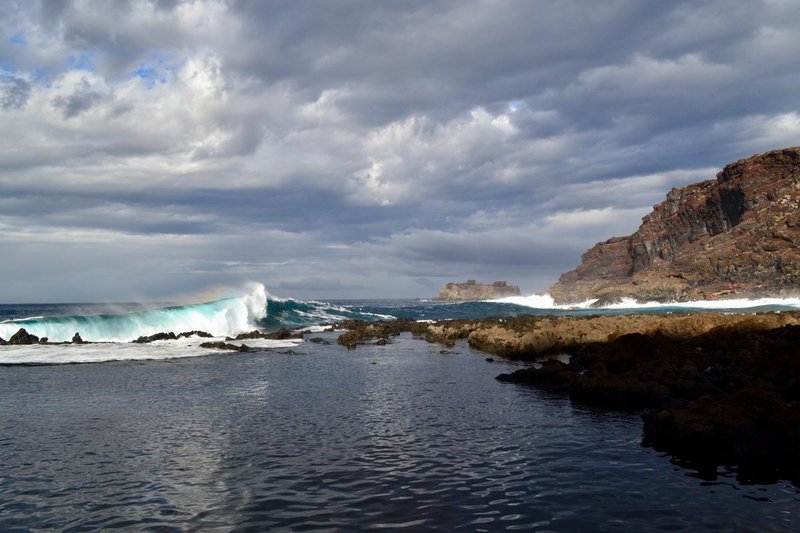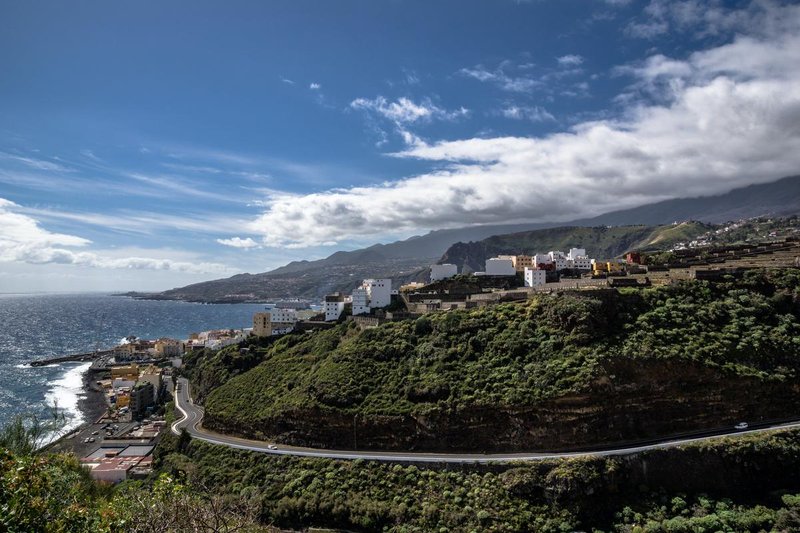Lanzarote

© Zinah Insignia
Know of any campsites on Lanzarote? Send us an email: [email protected]!You can get to the first of the Canary Islands — the volcanic island Lanzarote — from Cádiz on the Spanish mainland. Lanzarote is an island full of contrasts: Barren, moon-like landscapes formed by lava are balanced out with green, fertile fields. Be sure to check out the Montañas del Fuego in Timanfaya National Park. You can even explore the national park on foot or dromedary! Or spend another unforgettable day at the Jameos del Agua: Artist César Manrique developed these lava caves as an artistic and cultural site. In the evenings, you can listen to live music in the world’s only concert hall in a volcanic cave, indulge in exclusive dishes in a restaurant by a subterranean lake, or sip on a drink in the Caribbean-style pool complex.
Fuerteventura

© Jessy Hoffmann
Know of any campsites on Fuerteventura? Send us an email: [email protected]!After a 30-minute ferry ride from Playa Blanca, you’ll arrive at Corralejo on the neighbouring island of Fuerteventura. With more than 300 days of sun a year, Fuerteventura is a popular destination for many travellers looking to escape wintery weather. In addition to sunbathers, many surfers head to this barren desert island, and you can watch them ride the waves from different beaches such as Playa de Esquinzo and Playa de Garcey. If you’d also like to hop on a surfboard while you’re here, you’ll find everything you need at La Pared, on the western coast. Here, you’ll find turquoise waters and gorgeous sandy beaches, as well as several surfing schools. In the very southern part of the island, you’ll find another lovely beach with excellent waves: Playa de Jandía. You’ll find a great spot to go surfing, backdropped by a picturesque scene with the lighthouse.
Gran Canaria

© Miltiadis Fragkidis
Know of any campsites on Gran Canaria? Send us an email: [email protected]!Your next stop is on the island of Gran Canaria: You’ll drive ashore at the harbour of the capital, Las Palmas de Gran Canaria. Unlike on Fuerteventura, the island’s inland is teeming with palm tree gardens, coniferous forests, and green, terraced fields. An incredible highlight you won’t want to miss is a tour through or around the Bandama Caldera, which is about a 30-minute drive away from Las Palmas. Continue on to Pico de las Nieves, the island's highest point: On a clear day, you’ll enjoy a gorgeous panorama of the whole island from the summit. Don’t forget to bring long-sleeve shirts and trousers with you, though, because even when the sun is shining, the temperatures here are quite a bit lower than they are on the coast. Then, make your way through dizzying serpentine streets to the mountain village of Fataga, in the valley of the thousand palms. The town is only a short drive away from the island’s most beautiful beach, the Playa de Amadores, where a Caribbean atmosphere, excellent restaurants, and cocktail bars await. The coastal party hub, Puerto Rico, isn’t far from here; you can get there by strolling along the cliff-top path.
Tenerife

© Maxim Berg
Know of any campsites on Tenerife? Send us an email: [email protected]!You’ll then arrive at the harbour in Santa Cruz, on the largest of the Canary Islands. Since Tenerife has the most well-developed network of campsites, you have the opportunity to split your stay up, so you can spend a few days in the north of the island, followed by some time in the south. The northern part is ideal for active travellers because you can go on hikes up Mount Teide and through the Teide National Park here. If you’re more into soaking up the sun, being at the beach, and surfing, then you’ll love the Playa de las Americas beach. While you’re there, you can get to know the rugged nature of the southern coast, by going on a hike through the Masca gorge or go whale watching. Of course, as you plan your excursions, you should always take a close look at all the providers, so you can choose an organiser who is committed to the preservation of and the sustainable interaction with marine life as well as the rest of the island’s flora and fauna.
El Hierro

© Martin Godetz
Know of any campsites on El Hierro? Send us an email: [email protected]!From Tenerife, you’ll continue on to The End of the World, a nickname many travellers use to refer to El Hierro, the southernmost Canary Island. You’ll be welcomed with open arms here because, although the Canaries are a top holiday destination, many tourists tend to overlook it. That’s a huge mistake if you ask us: Absolute tranquillity, gorgeous nature, and indescribable hospitality await on El Hierro. The fertile soil provides the island with beautiful vegetation, and there are numerous hiking paths that traverse the landscape. One tour brings you to the Mirador de Jinama lookout point, which rewards those who complete the arduous 1,230 m climb with a magnificent view of the El Golfo valley. The island has mostly cliff coasts, so there are few places where you can go swimming in the sea here. Do as the locals do, and head to the Charco de los Sargos natural pools instead. Don’t forget your snorkelling gear: The natural underwater world here is just as indescribably beautiful as the rest of El Hierro!
La Gomera

© Siebe Bogaert
Know of any campsites on La Gomera? Send us an email: [email protected]!Your next stop brings you back up towards Teneriffa, to its next-door neighbour, La Gomera. You’ll arrive at the harbour of San Sebastián. Since camping tourism is still relatively new to the Canaries, there’s only one small campsite on La Gomera, and it’s exclusively for campers with tents. You may, however, spend one night on any of the car parks for hikers, as long as you don’t show any camping-like behaviour, such as setting up your awning. There are such strict camping-related regulations on La Gomera because the entire island is a UNESCO biosphere reserve. This makes it a dream-come-true for hikers! The circular path from Hermigua to El Credo is particularly beautiful: In about an eight-hour hike, you’ll walk through a centuries-old laurel forest and the Garajonay National Park. If you’re looking for some company after a lonely day in this primeval forest, make your way to the small, coastal town of Valle Gran Rey. Here, you’ll come across many bon vivants, hippies, and people who have gone off the grid: They tend to gather on the beach in the evenings to witness the spectacular sunset, to play guitar, and to swap stories.
La Palma

© Bastian Pudill
Know of any campsites on La Palma? Send us an email: [email protected]!The island of La Palma, also called La Isla Bonita, is the last stop on your motorhome tour of the Canaries. Like on La Gomera, there are no campsites for motorhomes here, but you may spend one night at designated spots and Zonas Recreativas. For campers in tents, though, there are several options. The widely acclaimed eternal spring of the Canaries is truly ever-present on La Palma, and the lush vegetation and rich plant life can be found around every corner. On the short trail to Los Tilos, you’ll cross a thick jungle and come across a gorgeous waterfall. You should also occasionally look up to the treetops, where colourful canaries and a variety of parrot species chirp. If you want to cool down on a hot day, take a dip in the cool Atlantic tides. The most beautiful snorkelling spots are off the coast at Zamora Grande and Zamora Chica. These are both marine reserves, home to countless types of fish.
The Canaries are absolutely gorgeous, and there’s an island to suit every type of traveller. On camping.info, you can find campsites in Spain as well as more inspiration for your next trip.
 Deutsch
Deutsch Nederlands
Nederlands français
français italiano
italiano Español
Español български
български босански
босански čeština
čeština dansk
dansk Ελληνικά
Ελληνικά eesti
eesti suomi
suomi hrvatski
hrvatski magyar
magyar lietuvių
lietuvių latviešu
latviešu norsk bokmål
norsk bokmål polski
polski português
português română
română русский
русский slovenčina
slovenčina slovenščina
slovenščina српски
српски svenska
svenska Türkçe
Türkçe